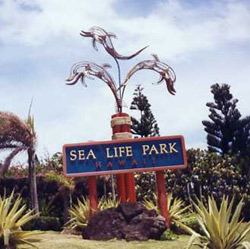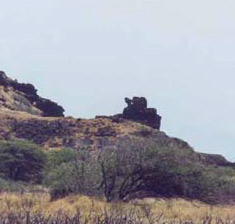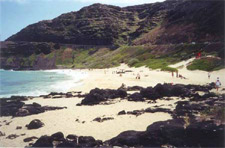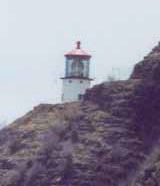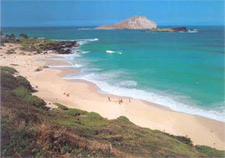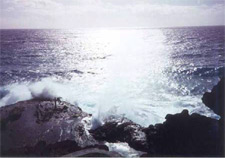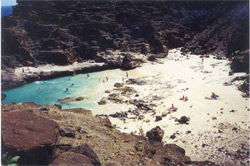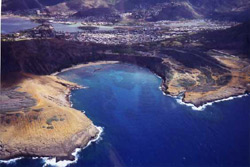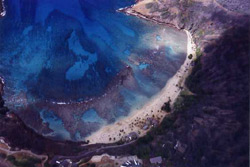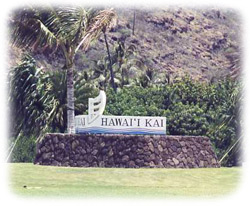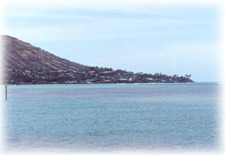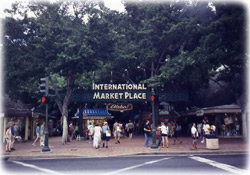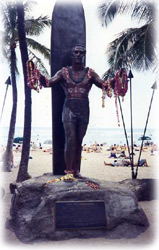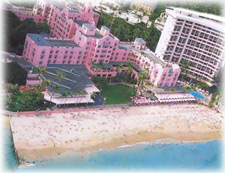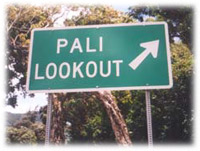
The Road to Pali Lookout
Pali Highway: From Trail to Highway.
In the early 1800’s you had two chooses if you wanted to travel betweenHonoluluand Windward O’ahu.
You could take a canoe trip around the southern end of the island or hike over the steep cliffs of the Ko’olau mountains. The Pali Lookout (cliff) trail was the quickest and most direct route but it was very steep and slippery. Hawaiian’s traveled the trail with ease but foreigners had a very different experience.
Foot Trail: The foot trail was traveled by people carrying containers of poi, bundles of taro and sweet potatoes, pigs, chickens, and goats to sell inHonolulu.
Horse Trail: In 1845, the crowded and dangerous path was paved with stone and widened to six feet. Travel toHonoluluon horse or mule took about three hours.
Carriage Road: In 1897, a new carriage road was built below the existing trail. Portions of the cliff were blasted to create a 20-foot wide road supported by stone walls. The road now wound around the mountain.
Horse and Buggy: A strong wind struck travelers at every turn and for safety, a wooden railing was added. The road was crowded with horses and mules pulling wagons of sugar, bananas, rice, and fish to market inHonolulu.
Highway: The carriage road handled the transition to car with little change until the 1950’s. The construction of the four-lane highway we travel today included excavation of the tunnels. The highway was completed in 1957.

Nu’uanu and Pali Lookout
Pali Lookout, the most famous spot in Nu’uanu, is the site of the Battle of Nu’uanu Pali: Uniting theIslands. In the late 1700’s, Kamehameha I, from theisland ofHawai’i, sought to unite all theHawaiian Islands under one rule. The battle for O’ahu began with the arrival of his forces atWaikīkī in 1795.
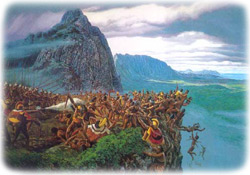 O’ahu had been defeated by Maui forces a decade earlier andMaui’s Chief Kalanikūpule now led the forces on O’ahu. After many hard fought battles, he was driven up Nu’uanu Valley to this location. Both sides fought with Hawaiian spears and Western firearms but Kamehameha’s cannon gave him the winning advantage.
O’ahu had been defeated by Maui forces a decade earlier andMaui’s Chief Kalanikūpule now led the forces on O’ahu. After many hard fought battles, he was driven up Nu’uanu Valley to this location. Both sides fought with Hawaiian spears and Western firearms but Kamehameha’s cannon gave him the winning advantage.
The battle, called Kaleleka’anae (leaping of the ‘anae fish), refers to the men forced off the cliff during the battle. There are two versions of what happened. One is that when defeat was certain, the warriors of O’ahu chose death over surrender and leaped from the cliffs to their death below. The other version is that the forces of Kamehameha drove the O’ahu warriors over the cliff and tossed after them the wounded. An estimated 400 warriors died in this battle. With Kamehameha’s victory, O’ahu joined Maui, Moloka’i, Lānai, Kaho’olawe, andHawai’iunder his rule. And with the signing of an agreement with Kauai and Ni’ihau, he became the first king of theHawaiian Islands.
Pali Lookout Conclusion
The weather at the Pali Lookout can be quite different from that of the city, often having high winds and some times rain, it really should be considered a “must see” spot during your visit to Oahu. Do get up there and take in the view of Pali Lookout, you’ll be glad you did.
